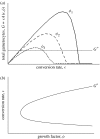On the evolution of reproductive restraint in malaria
- PMID: 18303001
- PMCID: PMC2602685
- DOI: 10.1098/rspb.2007.1545
On the evolution of reproductive restraint in malaria
Abstract
Malaria is one of the leading causes of death among infectious diseases in the world, claiming over one million lives every year. By these standards, this highly complex parasite is extremely successful at generating new infections. Somewhat surprisingly, however, many malaria species seem to invest relatively little in gametocytes, converting only a small percentage of circulating asexual parasite forms into this transmissible form. In this article, we use mathematical models to explore three of the hypotheses that have been proposed to explain this apparent 'reproductive restraint' and develop a novel, fourth hypothesis. We find that only one of the previous three hypotheses we explore can explain such low gametocyte conversion rates, and this hypothesis involves a very specific form of density-dependent transmission-blocking immunity. Our fourth hypothesis also provides a potential explanation and is based on the occurrence of multiple infections and the resultant within-host competition between malaria strains that this entails. Further experimental work is needed to determine which of these two hypotheses provides the most likely explanation.
Figures


References
-
- Al-Olayan E.M, Williams G.T, Hurd H. Apoptosis in the malaria protozoan, Plasmodium berghei: a possible mechanism for limiting intensity of infection in the mosquito. Int. J. Parasitol. 2002;32:1133–1143. doi:10.1016/S0020-7519(02)00087-5 - DOI - PubMed
-
- Anderson R.A, Knols B.G.J, Koella J.C. Plasmodium falciparum sporozoites increase feeding-associated mortality of their mosquito hosts Anopheles gambiae s.l. Parasitology. 2000;120:329–333. doi:10.1017/S0031182099005570 - DOI - PubMed
-
- Babiker H.A, Ranford-Cartwright L.C, Walliker D. The epidemiology of multiple Plasmodium falciparum infections—3, Genetic structure and dynamics of Plasmodium falciparum infections in the Kilombero region of Tanzania. Trans. R. Soc. Trop. Med. Hyg. 1999;93:S11–S14. doi:10.1016/S0035-9203(99)90321-8 - DOI - PubMed
-
- Bell A.S, Roode J.C.D, Sim D, Read A.F. Within-host competition in genetically diverse malaria infections: parasite virulence and competitive success. Evolution. 2006;60:1358–1371. doi:10.1554/05-611.1 - DOI - PubMed
-
- Bromwich C.R, Schall J.J. Infection dynamics of Plasmodium mexicanum, a malarial parasite of lizards. Ecology. 1986;67:1227–1235. doi:10.2307/1938678 - DOI
Publication types
MeSH terms
LinkOut - more resources
Full Text Sources
Medical
Molecular Biology Databases
